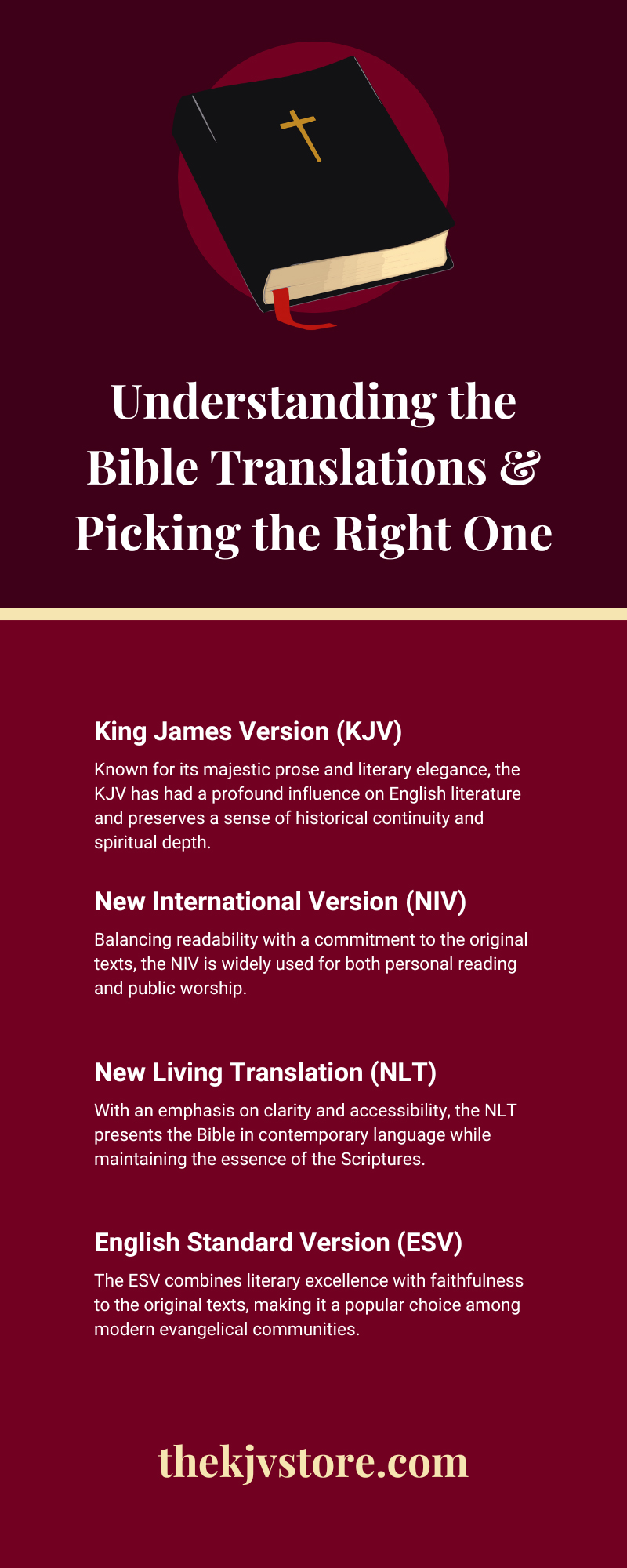Understanding the Bible Translations & Picking the Right One

The Bible was originally written in three languages: Hebrew, Aramaic, and Koine Greek. Over the centuries, these foundational texts have been translated into numerous languages, adapting to the linguistic shifts and needs of diverse communities. This process of translation has not only preserved the Scriptures but also made them accessible to millions, enabling people to engage with the Word of God in their own languages.
Understanding the Bible translations and picking the right one is important for spiritual growth. Explore the development of Bible translations and how these adaptations affect personal faith and comprehension of God’s Word.
The Bible’s Original Languages
The Bible's original languages, Hebrew, Aramaic, and Koine Greek, were prevalent during the periods of the Bible's composition. The Hebrew used in the Bible, known as Biblical Hebrew, differs significantly from Modern Hebrew in terms of vocabulary, grammar, and structure due to centuries of linguistic evolution. Aramaic, a Semitic language closely related to Hebrew, was widely used in the Near East. Koine Greek emerged as a common dialect in the Eastern Mediterranean after Alexander the Great's conquests.
In the Bible, Hebrew is predominantly found in the Old Testament, where it conveys the laws, history, and poetry of the Jewish people. Aramaic appears in select parts of the Old Testament, such as portions of Daniel and Ezra, and it was likely the spoken language of Jesus. The New Testament is primarily written in Koine Greek, which was the lingua franca of the Hellenistic world. Koine Greek facilitated the spread of Christian messages.
Early History of Bible Translations
The Vulgate was a late-4th-century Latin translation of the Bible that played a significant role in making the Scriptures accessible to people who spoke Latin. Largely completed by Jerome, an early Christian priest, the Vulgate was a milestone in shaping Christian theology and practice for centuries. It set a precedent for future translations by striving to balance fidelity to the original texts with readability.
Vernacular Translations
Vernacular language refers to the native language spoken by ordinary people in a specific region or country. The shift to vernacular Bible translations began in the Renaissance and Reformation, driven by a growing desire for direct access to the Scriptures.
Key figures, including Martin Luther and William Tyndale, translated the Bible into German and English, respectively, enabling everyday people to read it in their own languages. This democratization of religious texts greatly enhanced personal understanding and sparked significant religious reforms across Europe.
Translation Methodologies
Two main translation methodologies—formal equivalence and dynamic equivalence—are used to render the Bible’s original texts into another language. They each have their own approach to balancing accuracy, readability, and interpretive depth. By comparing these approaches, Christians can gain a better understanding of Bible translations and pick the right one for their purposes.
Formal Equivalence
Formal equivalence, or word-for-word translation, aims to preserve the exact wording and structure of the original texts. This approach prioritizes accuracy and is often preferred for in-depth study and theological analysis. However, it can sometimes result in awkward or difficult-to-read passages in the target language.
Dynamic Equivalence
Dynamic equivalence, or thought-for-thought translation, focuses on conveying the original meaning and intent of the texts. This approach emphasizes readability and comprehension, making it more accessible for general reading. However, sacrificing literal accuracy in dynamic equivalence might lead to misinterpretations or loss of nuanced meanings present in the original text.
The Most Popular English Translations
Every few years, a new Bible translation is released, often reflecting updated scholarship and contemporary language use. However, certain translations, such as the King James Version and the New International Version, maintain enduring popularity.
The list below compares the unique characteristics of the most popular English translations of the Bible:
- King James Version (KJV): Known for its majestic prose and literary elegance, the KJV has had a profound influence on English literature and preserves a sense of historical continuity and spiritual depth.
- New International Version (NIV): Balancing readability with a commitment to the original texts, the NIV is widely used for both personal reading and public worship.
- New Living Translation (NLT): With an emphasis on clarity and accessibility, the NLT presents the Bible in contemporary language while maintaining the essence of the Scriptures.
- English Standard Version (ESV): The ESV combines literary excellence with faithfulness to the original texts, making it a popular choice among modern evangelical communities.
Tips for Choosing the Right Translation
When selecting a Bible translation, you can consider several factors, including your purpose for reading, your level of familiarity with biblical texts, and the specific doctrinal beliefs or preferences you may hold.
Evaluate Readability
Choosing a Bible translation with good readability is key to understanding and engaging with the text. To gauge readability, look at sentence structure, vocabulary, and flow. Sampling different translations can help find one that suits you. Opting for a translation at your reading level will improve comprehension and deepen your connection to the Scriptures.
Importance of Study Aids
Referencing the Bible's study aids, such as translation tools, in-text commentaries, cross-references, charts, and graphs, significantly enhances comprehension and interpretation of the Scriptures. These resources allow readers to better understand context, compare various translations, and uncover deeper meanings within the text.
By providing insight into cultural, historical, and linguistic backgrounds, study aids facilitate a more informed engagement with biblical passages. Premium leather Bibles may offer these or other tools to enrich the study experience and help in applying biblical teachings to everyday life.
Check Translation Philosophy
Being aware of the approach translators took when adapting the original texts is essential for understanding the balance between accuracy and readability in the translated versions. Look for information provided by the translation team about whether they employed formal or dynamic equivalence, which can indicate how closely the translation adheres to the original wording versus conveying its intended meaning. Additionally, consulting reviews or critiques from reputable biblical scholars can provide further insights into how well the translation philosophy aligns with your personal reading needs and spiritual goals.
Evaluating Bible translations requires an understanding of both the historical context and the translation methods employed. The importance of the original languages and the shift towards vernacular translations reflect an ongoing commitment to making Scripture accessible to all. By weighing the pros and cons of formal and dynamic equivalence, readers can select translations that enhance their study and personal devotion.

